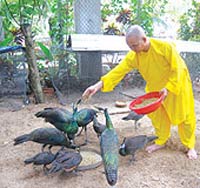The secret of breeding birds
Every year in Ho Son ancient bird garden (Tuy Hoa city, Phu Yen province) there are about 30 young public uncle born. With the way of hatching ' mother chickens ' created by the monk of this temple, the hatching rate of the temple always reaches 100%.
Ancient Ho Son is located in the heart of Tuy Hoa City, but surrounded by villages and gardens, shady green trees seem to be separate from the urban noise. In a rather unique natural setting, there is a bird garden with more than 1 acre of land with many birds such as pigeons Pan, turkey, riot chicken, star chicken, red pheasant .
But attracting the attention of visitors is that there are dozens of big and small uncle who are 'pulling their necks, spreading their wings' showing off colorful and noble fur. Venerable Thich Nguyen Duc, 65, the abbot of Ho Son Pagoda, was the founder of that bird garden.
Unique ' technology ': Mother chicken peacock

Venerable Thich Nguyen Duc is taking care of the public
Raising the public since 1975, but until the early 1990s, Venerable Thich Nguyen Duc found a method of public breeding not in books: ' mother chicken peacock '. Public eggs laid out, he gave immediately to the broody hen (not waiting for the new nest for the hamlet because so the hatching rate did not reach high), on average each chicken incubated 6 public eggs. After 30 days, hatching, the chicken mother will take the child to eat like . take care of the chicks for more than 2 months, then can live independently.
Why leave chickens to breed and raise animals in the first days of life? Mr. Thich Nguyen Duc explained: ' The mother often does not go well because everyone sees that they come up and get out of the drive, resulting in a low incidence of hatching eggs. In addition, it has a very . noble way of life. Before eating something, they often observe very carefully, eat slowly, not strabismus such as chicken or some other poultry species. In contrast, mother chickens often stimulate their children to eat very well by prey and feed their children. The young labor was raised by the mother chicken so it grew very quickly . '
Thanks to this ' technology ', Mr. Thich Nguyen Duc, a public breeder, was very successful. Three peacocks in the temple garden each year give birth to more than 30 eggs. Six hens will take turns brooding and raising 30 uncle children. The abbot also ' trained ' the chickens ' practice ' of birth at the same time as the incubation period so that at the stage of incubation, it is possible to replace the incubation task and create a 'practice' to extend the incubation period (more than 1 week against chicken incubation).
The old monk also revealed about the technique of farming: The gong must be raised in a barn, with an area of 100 m2 or more. The net roof is not covered with corrugated iron, in rainy months, it can cover the canvas, but when it is sunny, it must be opened immediately to get the sunlight. Because of the loose division, the floor must be covered with a 5-6 inch thick layer of sand, plant green trees to water this plant when watering.
Releasing the forest to the forest
Since 1992, Mr. Thich Nguyen Duc said he kept the annual habit of releasing two pairs of workers about 4-5 months old, when they were able to live independently, returning to the forest in the hope that they would proliferate. flourish more. ' Both Pass forest and forest in the area near Dong Cam dam are places where I often release every year. These are forest areas with a lot of food and water - a kind of 'food' that is indispensable to the peacocks ' - he said.
The amount of child labor that is growing more and more, the temple is not enough to raise, besides giving gifts, Thich Nguyen Duc also sells to many people who like to raise ornamental birds in Tuy An, Song Cau, Son Hoa, Dong Xuan . to ask to buy, even have an order with a few dozen children.
Lessons and photos: Quoc Khuong
- The real reason why birds migrate
- The secret life of penguins
- Birds never ... fly
- Why do Asian migratory birds stop in Europe?
- Birds singing also has grammar!
- Do not destroy breeding birds in the epidemic area
- The secret strategic love song of birds
- Detecting secret communication methods of humpback whales
- Admire birds only in Africa
- Unbelievable records of birds
- The flock of birds appears in Lao Cai as a swallow
- Ho Chi Minh City still temporarily allows breeding birds
 'Barefoot engineer' invents a pipeless pump
'Barefoot engineer' invents a pipeless pump Process of handling dead pigs due to disease
Process of handling dead pigs due to disease Radiometer
Radiometer Warp Engine: Technology brings us closer to the speed of light
Warp Engine: Technology brings us closer to the speed of light